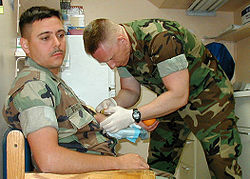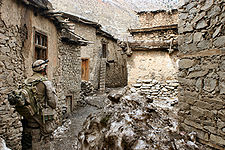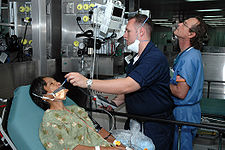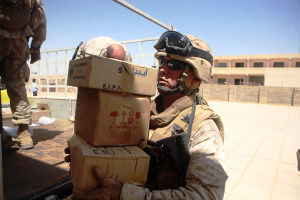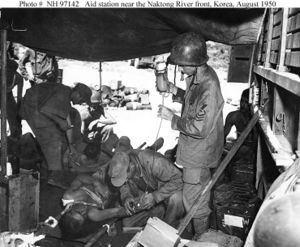United States Navy Hospital Corpsman
This article's citation style may be unclear. The references used may be made clearer with a different or consistent style of citation, footnoting, or external linking. (September 2009) |
A Hospital Corpsman (HM) (pronounced "core-man") is frequently the only medical care-giver available in many fleet or Marine units on extended deployment. Hospital Corpsmen serve as enlisted medical specialists for the United States Navy and the United States Marine Corps. The Hospital Corpsman works in a wide variety of capacities and locations, including shore establishments such as naval hospitals and clinics, aboard ships, as the primary medical caregivers for sailors while underway. Hospital Corpsman perform duties as assistants in the prevention and treatment of disease and injury and assist health care professionals in providing medical care to Navy people and their families. They may function as clinical or specialty technicians, medical administrative personnel and health care providers at medical treatment facilities. They also serve as battlefield corpsmen with the Marine Corps, rendering emergency medical treatment to include initial treatment in a combat environment. Qualified hospital corpsmen may be assigned the responsibility of independent duty aboard ships and submarines; Fleet Marine Force, Special Forces and Seabee units, and at isolated duty stations where no medical officer is available.
The colloquial form of address for a Hospital Corpsman is "Doc". In the U.S. Marine Corps, this term is generally used as a sign of respect.
Contents
- 1 History
- 2 Organization
- 3 Hospital Corpsman Pledge
- 4 Hospital Corpsman Prayer
- 5 The One Called "Doc"
- 6 Today's Hospital Corpsman rate/rating structure
- 7 Badges
- 8 Ships named in honor of Hospital Corpsmen
- 9 U.S. Navy enlisted medical personnel killed in action
- 10 Noteworthy Hospital Corpsmen
- 11 Decorations of valor awarded to Hospital Corpsmen
- 12 Iwo Jima flag-raising
- 13 United States Maritime Service Hospital Corpsmen
- 14 See also
- 15 References
- 16 External links
History
Prior to the establishment of the Hospital Corps, enlisted medical support in the Navy was limited in scope. In the Continental Navy and the early U.S. Navy, medical assistants were assigned at random out of the ship's company. Their primary duties were to keep the irons hot and buckets of sand at the ready for the operating area. It was commonplace during battle for the surgeons to conduct amputations and the irons were used to close the cuts and the sand was to keep the surgeon from slipping on the bloody deck. They were commonly referred to as Loblolly Boy, a term borrowed from the British Royal Navy, and a reference to the daily ration of porridge fed to the sick. The nickname was in common use for so many years that it was finally officially recognized by the Navy Regulations of 1814. In coming decades, the title of the enlisted medical assistant would change several times - from Loblolly Boy, to Nurse (1861), and finally to Bayman (1876). A senior enlisted medical rate, Surgeon's Steward, was introduced in 1841 and remained through the Civil War. Following the war, the title Surgeon's Steward was abolished in favor of Apothecary, a position requiring completion of a course in pharmacy.
Still, there existed pressure to reform the enlisted component of the Navy's medical department - medicine as a science was advancing rapidly, foreign navies had begun training medically skilled sailors, and even the U.S. Army had established an enlisted Hospital Corps in 1887. Navy Surgeon General J.R Tyron and subordinate physicians lobbied the Navy administration to take action. With the Spanish-American War looming, Congress passed a bill authorizing establishment of the U.S. Navy Hospital Corps, signed into law by President William McKinley on 17 June 1898. Three rates were created therein — Hospital Apprentice, Hospital Apprentice First Class (a petty officer third class), and Hospital Steward, which was a chief petty officer.
A revision in 1916 established a new rate structure. With the introduction of a second junior rate there were now Hospital Apprentice Second Class (HA2c) and Hospital Apprentice First Class (HA1c). The rating title for petty officers was established as Pharmacist's Mate (PhM), following the pattern of some of the Navy's other ratings (boatswain's mate, gunner's mate, etc.). Pharmacist's Mate Third Class (PhM3c), Second Class (PhM2c), and First Class (PhM1c) were now the petty officers, and Chief Pharmacist's Mate (CPhM) was the CPO. This structure that would remain in place until 1947.
During World War I, hospital corpsmen served throughout the fleet, earning particular distinction on the Western Front with the Marine Corps. A total of 684 personal awards were awarded to hospital corpsmen in the war, including 2 Medals of Honor, 55 Navy Crosses, and 237 Silver Stars.
In World War II, hospital corpsmen hit the beach with Marines in every battle in the Pacific. Joe Rosenthal's iconic photo of the flag-raising on Iwo Jima, captured during that battle's early days, depicts Pharmacist's Mate Second ClassJohn Bradley among the group of Marines on Mt. Suribachi that day. They also served on thousands of ships and submarines. Notably, three unassisted emergency appendectomies were performed by hospital corpsmen serving undersea and beyond hope of medical evacuation. The Hospital Corps has the distinction of being the only corps in the U.S. Navy to be singled out in a famous speech by Secretary of the Navy James Forrestal after the conclusion of the war.[1]
Following the war, the Hospital Corps changed its rating title to the generic term it had used all along—Hospital Corpsman. The rates of hospital corpsman third class (HM3), second class (HM2), and first class (HM1), and chief hospital corpsman (HMC) were supplemented by senior chief hospital corpsman (HMCS) and master chief hospital corpsman (HMCM) in 1958.
Hospital corpsmen continued to serve at sea and ashore, and accompanied Marine units into battle during the Korean and Vietnam wars. Fifteen hospital corpsmen were counted among the dead following the bombing of the Marine barracks in Beirut in 1983. Today, hospital corpsmen are serving in the Iraq and Afghanistan wars.
Prior to selection to the Command Master Chief program, the 11th MCPON, Joe R. Campa, was a Hospital Corpsman.
Organization
Because of the need for Hospital Corpsmen in a vast array of foreign, domestic, and shipboard duty stations, as well as with United States Marine Corps units, the Hospital Corps is the largest rating in the United States Navy.
The basic training for Hospital Corpsmen is Naval Hospital Corps School, located in Great Lakes, IL, one of the Navy's "A" schools (primary rating training). Upon graduation, the Hospital Corpsman is given the Navy Enlisted Classification (NEC) code of HM-0000, or "quad-zero" in common usage. NECs are analogous to MOS in the United States Army and Marine Corps, or AFSC in the Air Force. There are primary NECs, and secondary NECs. For example, a Hospital Corpsman who completes Field Medical Training Battalion (FMTB) and earns the NEC HM-8404, moves that NEC to primary and has a secondary NEC of HM-0000. If that Hospital Corpsman attends a "C" School, then the NEC earned at the "C" School becomes their primary and HM-8404 becomes the secondary. Some Hospital Corpsmen go on to receive more specialized training in roles such as Medical Laboratory Technician, Radiology Technician, Aviation/Aerospace Medicine Specialist, Pharmacy Technician, Operating Room Technician, etcetera. This advanced education is done through "C" schools, which confer additional NECs. Additionally, Hospital Corpsmen E-5 and up may attend "B" school, qualifying for independent duty in surface ships and submarines, with diving teams, and Fleet Marine Force Recon teams, as well as at remote shore installations. In addition to advanced medical training, these Hospital Corpsmen receive qualification in sanitation and public health.
Of note is Field Medical Training Battalion (FMTB), with locations at Camp Pendleton and Camp Johnson, where sailors bound for service with USMC operating forces earn the NEC HM-8404, Field Medical Service Technician. FMTB provides specialized training in advanced emergency medicine and the fundamentals of Marine Corps life, while emphasizing physical conditioning, small arms familiarity, and basic battlefield tactics. As of 2010, this rigorous training is eight weeks long. [1] Training for the Fleet Marine Force (FMF) familiarizes Navy Corpsmen with the Marines. A bond and mutual respect is often formed between Marines and their assigned Hospital Corpsmen, earning respect apart from their Navy shipmates. FMF Hospital Corpsmen wear the uniforms of the Marine Corps while on duty with the Marine Corps. If not, they wear the Navy's new working uniforms. It has been proposed that all male Hospital Corpsmen be required to attend Field Medical Training Battalion (FMTB).
Hospital Corpsmen can further specialize, Special Amphibious Reconnaissance Corpsman, or SARC. They are usually found in both the FMF Recon and Marine Division Recon and MARSOC units. They are trained and skilled in combat, including combatant swimming, opened/closed circuit scuba diving, military free-fall and amphibious operations. They act as advisers regarding health and injury prevention, and treat illnesses from decompression sickness as well as other conditions requiring hyperbaric treatment.
Hospital Corpsmen who have received the warfare designator of Enlisted Fleet Marine Force Warfare Specialist are highly trained members of the Hospital Corps who specialize in all aspects of working with the United States Marine Corps operating forces. Attainment of this designation is highly prized among all Corpsmen. The Enlisted Fleet Marine Force Warfare designation for Hospital Corpsmen is the only US Navy warfare device awarded solely by a US Marine Corps General Officer. This awarding authority cannot be delegated to US Navy Officers. However, obtaining the title of "FMF" is a rigorous procedure and not every Hospital Corpsman who has been with a Marine Corps unit will wear the FMF warfare device. U.S. Navy officers in the medical community(Medical Corps (Doctor), Nurse Corps, Dental Corps) can earn and wear the officer equivalent to this insignia. Additionally any sailor attached to a Marine unit can earn and wear an FMF warfare device. (Example, administrative rates such as Logistic Specialists)
Be they assigned to hospital ships, reservist installations, recruiter offices, or Marine Corps combat units, the rating of Hospital Corpsman is the most decorated in the United States Navy with 22 Medals of Honor, 174 Navy Crosses, 31 Distinguished Service Medals, 946 Silver Stars, and 1,582 Bronze Stars. [2] There have been 20 naval ships that have been named after hospital corpsmen.
Hospital Corpsman Pledge
"I solemnly pledge myself before God and these witnesses to practice faithfully all of my duties as a member of the Hospital Corps. I hold the care of the sick and injured to be a privilege and a sacred trust and will assist the Medical Officer with loyalty and honesty. I will not knowingly permit harm to come to any patient. I will not partake of nor administer any unauthorized medication. I will hold all personal matters pertaining to the private lives of patients in strict confidence. I dedicate my heart, mind and strength to the work before me. I shall do all within my power to show in myself an example of all that is honorable and good throughout my naval career."
Hospital Corpsman Prayer
Grant me, oh Lord, for the coming events;
Enough knowledge to cope and some plain common sense.
Be at our side on those nightly patrols;
And be merciful judging our vulnerable souls.
Make my hands steady and as sure as a rock;
when the others go down with a wound or in shock.
Let me be close, when they bleed in the mud;
With a tourniquet handy to save precious blood.
Here in the jungle, the enemy near;
Even the corpsman can't offer much lightness and cheer.
Just help me, oh Lord, to save lives when I can;
Because even out there is merit in man.
If it's Your will, make casualties light;
And don't let any die in the murderous night.
These are my friends I'm trying to save;
They are frightened at times, but You know they are brave.
Let me not fail when they need so much;
But to help me serve with a compassionate touch.
Lord, I'm no hero—my job is to heal;
And I want You to know Just how helpless I feel.
Bring us back safely to camp with dawn;
For too many of us are already gone.
Lord bless my friends If that's part of your plan;
And go with us tonight, when we go out again."
The One Called "Doc"
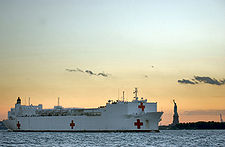
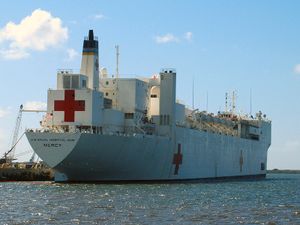
I'm the one called "Doc"
I shall not walk in your footsteps,
but I will walk by your side.
I shall not walk in your image,
I've earned my own title of pride.
We've answered the call together,
on sea and foreign land.
When the cry for help was given,
I've been there right at hand.
Whether I am on the ocean
or in the jungle wearing greens,
Giving aid to my fellow man,
be it Sailors or Marines.
So the next time you see a corpsman
and you think of calling him "squid,"
think of the job he's doing
as those before him did.
And if you ever have to go out there
and your life is on the block,
Look at the one right next to you...
I'm the one called "Doc."
Harry D. Penny, Jr. HMC(AC) USN
Copyright 1975
Today's Hospital Corpsman rate/rating structure
|
|
Badges
- See: List of United States Navy ratings#Administration, deck, medical, technical, and weapons specialty ratings (at "Hospital Corpsman")
Ships named in honor of Hospital Corpsmen
Reference: Dictionary of American Naval Fighting Ships
|
|
- Total in all conflicts: 2,012
Noteworthy Hospital Corpsmen
- Bill Cosby, Comedian and Actor
- Robert Eugene Bush, World War II Medal of Honor recipient featured in Tom Brokaw's book The Greatest Generation
- Esther Snyder, co-founder and president of In-N-Out Burger[citation needed]
- Bob Stump, U.S. Congressman from Arizona, 1977–2003
- David Ferriero, 10th Archivist of the United States
Decorations of valor awarded to Hospital Corpsmen
- Medal of Honor, 22
- Navy Cross, 174
- Distinguished Service Cross (United States Army), 31
- Silver Star, 946
- Bronze Star, 1,582
Hospital Corpsmen who received the Medal of Honor
- Pre-World War I
- Hospital Apprentice Robert H. Stanley, USN (Boxer Rebellion)
- Hospital Apprentice First Class William Zuiderveld, USN (Veracruz Incursion)
- Hospital Apprentice Fred H. McGuire, USN (Philippine Insurrection)
- Hospital Steward William S. Shacklette, USN (Boiler Explosion in San Diego)
|
|
Iwo Jima flag-raising
PhM2/c John Bradley, USN, a Hospital Corpsman, was one of the six men photographed by Joe Rosenthal raising the second United States flag on Iwo Jima during World War II. He is the only one whose face is visible.
United States Maritime Service Hospital Corpsmen
During World War II, the United States Maritime Service created a Hospital Corps similar to the Navy's and sent pursers through this Hospital Corpsman training, to serve in a combined administrative and medical role on civilian tankers, freighters, and oilers. Prior to this, there were no competent trained personnel to perform first aid aboard these vessels. The Purser-Corpsman was trained in anatomy, physiology, pharmacy, clinical laboratory, hygiene and sanitation, emergency treatment, first aid, and nursing. They were taught how to administer injections, treat compound fractures, administer blood plasma, and suture wounds.
The Maritime Service’s Hospital Corps School was founded at the Sheepshead Bay training station on December 7, 1942. Surgeon S.S. Heilwell (R), United States Uniformed Public Health Service, was placed in charge of training. The course was taught over four months, with a 12 week period of didactic classroom experience and four weeks of practical experience at a Marine hospital. The original class of 331 students resulted in 239 graduates on March 12, 1943, but demand saw an increase in the class to 600 students, to cycle in 50 student classes starting on a weekly basis. Training stations were instructed to provide careful scrutiny by examining boards for all candidates. Pursers on sea duty started arriving at the station on August 10, 1943. By January 1, 1944, there were 600 Purser-Corpsmen at sea, with 1,324 graduates in the Maritime Service.
Selection required an above average mark on the General Classification Test and definite interest in both administration and health care. A survey reveals that the men have an IQ average of 130 and two years of college. Pursers entering the hospital school are given ratings according to the length of time they have spent at sea. Those serving less than six months are given chief petty officer ratings and those with more than six months at sea receive ensign ratings. Of the 50 men who enter the school each week, 30 are pursers and 20 were apprentice seaman.
- Work Cited: Mast Magazine May 1944, Mast Magazine August 1944, Mast Magazine May 1945
See also
References
- ↑ "FMSS Student Handbook". Brookside Press. Retrieved 2007-10-23.
- ↑ BMC Mayport (2003-06-19). "Happy 105th Birthday To The Hospital Corps".
